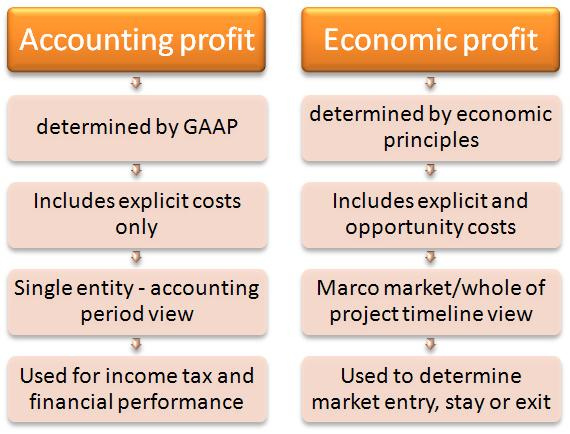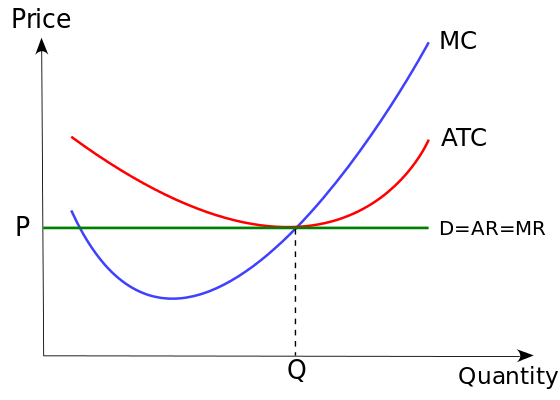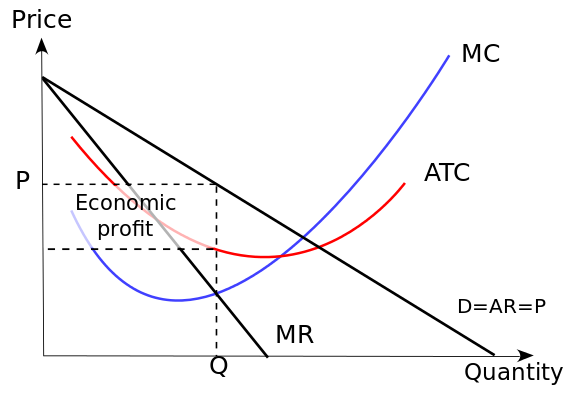9.3: Economic Profit
- Last updated
- Save as PDF
- Page ID
- 3486

- Boundless
- Boundless
Difference Between Economic and Accounting Profit
Economic profit consists of revenue minus implicit (opportunity) and explicit (monetary) costs; accounting profit consists of revenue minus explicit costs.
LEARNING OBJECTIVES
- Distinguish between economic profit and accounting profit
The term “profit” may bring images of money to mind, but to economists, profit encompasses more than just cash. In general, profit is the difference between costs and revenue, but there is a difference between accounting profit and economic profit. The biggest difference between accounting and economic profit is that economic profit reflects explicit and implicit costs, while accounting profit considers only explicit costs.
Explicit and Implicit Costs
Explicit costs are costs that involve direct monetary payment. Wages paid to workers, rent paid to a landowner, and material costs paid to a supplier are all examples of explicit costs.
In contrast, implicit costs are the opportunity costs of factors of production that a producer already owns. The implicit cost is what the firm must give up in order to use its resources; in other words, an implicit cost is any cost that results from using an asset instead of renting, selling, or lending it. For example, a paper production firm may own a grove of trees. The implicit cost of that natural resource is the potential market price the firm could receive if it sold it as lumber instead of using it for paper production.
Accounting Profit
Accounting profit is the difference between total monetary revenue and total monetary costs, and is computed by using generally accepted accounting principles (GAAP). Put another way, accounting profit is the same as bookkeeping costs and consists of credits and debits on a firm’s balance sheet. These consist of the explicit costs a firm has to maintain production (for example, wages, rent, and material costs). The monetary revenue is what a firm receives after selling its product in the market.
Accounting profit is also limited in its time scope; generally, accounting profit only considers the costs and revenue of a single period of time, such as a fiscal quarter or year.
Economic Profit
Economic profit is the difference between total monetary revenue and total costs, but total costs include both explicit and implicit costs. Economic profit includes the opportunity costs associated with production and is therefore lower than accounting profit. Economic profit also accounts for a longer span of time than accounting profit. Economists often consider long-term economic profit to decide if a firm should enter or exit a market.

Economic vs. Accounting Profit: The biggest difference between economic and accounting profit is that economic profit takes implicit, or opportunity, costs into consideration.
Sources and Determinants of Profit
Whether economic profit exists or not depends how competitive the market is, and the time horizon that is being considered.
LEARNING OBJECTIVES
- Describe sources of economic profit
Economic profit is total revenue minus explicit and implicit (opportunity) costs. In contrast, accounting profit is the difference between total revenue and explicit costs- it does not take opportunity costs into consideration, and is generally higher than economic profit.
Economic profits may be positive, zero, or negative. If economic profit is positive, other firms have an incentive to enter the market. If profit is zero, other firms have no incentive to enter or exit. When economic profit is zero, a firm is earning the same as it would if its resources were employed in the next best alternative. If the economic profit is negative, firms have the incentive to leave the market because their resources would be more profitable elsewhere. The amount of economic profit a firm earns is largely dependent on the degree of market competition and the time span under consideration.
Competitive Markets
In competitive markets, where there are many firms and no single firm can affect the price of a good or service, economic profit can differ in the short-run and in the long-run.
In the short run, a firm can make an economic profit. However, if there is economic profit, other firms will want to enter the market. If the market has no barriers to entry, new firms will enter, increase the supply of the commodity, and decrease the price. This decrease in price leads to a decrease in the firm’s revenue, so in the long-run, economic profit is zero. An economic profit of zero is also known as a normal profit. Despite earning an economic profit of zero, the firm may still be earning a positive accounting profit.

Long-Run Profit for Perfect Competition: In the long run for a firm in a competitive market, there is zero economic profit. Graphically, this is seen at the intersection of the price level with the minimum point of the average total cost (ATC) curve. If the price level were set above ATC’s minimum point, there would be positive economic profit; if the price level were set below ATC’s minimum, there would be negative economic profit.
Uncompetitive Markets
Unlike competitive markets, uncompetitive markets – characterized by firms with market power or barriers to entry – can make positive economic profits. The reasons for the positive economic profit are barriers to entry, market power, and a lack of competition.
- Barriers to entry prevent new firms from easily entering the market, and sapping short-run economic profits.
- Market power, or the ability to affect market prices, allows firms to set a price that is higher than the equilibrium price of a competitive market. This allows them to make profits in the short run and in the long run. This situation can occur if the market is dominated by a monopoly (a single firm), oligopoly (a few firms with significant market control), or monopolistic competition (firms have market power due to having differentiated products).
- Lack of competition keeps prices higher than the competitive market equilibrium price. For example, firms can collude and work together to restrict supply to artificially keep prices high.

Long-Run Profit for Monopoly: In the long run, a monopoly, because of its market power, can set a price above the competitive equilibrium and earn economic profit. If price were set equal to the minimum point of the average total cost (ATC) curve, the monopoly would earn zero economic profit. If the price were set lower than the minimum of ATC, the firm would earn negative economic profit.
Key Points
- Explicit costs are monetary costs a firm has. Implicit costs are the opportunity costs of a firm’s resources.
- Accounting profit is the monetary costs a firm pays out and the revenue a firm receives. It is the bookkeeping profit, and it is higher than economic profit. Accounting profit = total monetary revenue- total costs.
- Economic profit is the monetary costs and opportunity costs a firm pays and the revenue a firm receives. Economic profit = total revenue – (explicit costs + implicit costs).
- Economic profit = total revenue – ( explicit costs + implicit costs). Accounting profit = total revenue – explicit costs.
- Economic profit can be positive, negative, or zero. If economic profit is positive, there is incentive for firms to enter the market. If profit is negative, there is incentive for firms to exit the market. If profit is zero, there is no incentive to enter or exit.
- For a competitive market, economic profit can be positive in the short run. In the long run, economic profit must be zero, which is also known as normal profit. Economic profit is zero in the long run because of the entry of new firms, which drives down the market price.
- For an uncompetitive market, economic profit can be positive. Uncompetitive markets can earn positive profits due to barriers to entry, market power of the firms, and a general lack of competition.
Key Terms
- explicit cost: A direct payment made to others in the course of running a business, such as wages, rent, and materials, as opposed to implicit costs, which are those where no actual payment is made.
- implicit cost: The opportunity cost equal to what a firm must give up in order to use factors which it neither purchases nor hires.
- economic profit: The difference between the total revenue received by the firm from its sales and the total opportunity costs of all the resources used by the firm.
- accounting profit: The total revenue minus costs, properly chargeable against goods sold.
- normal profit: The opportunity cost of an entrepreneur to operate a firm; the next best amount the entrepreneur could earn doing another job.
LICENSES AND ATTRIBUTIONS
CC LICENSED CONTENT, SPECIFIC ATTRIBUTION
- Profit - the difference between economic and accounting costs, economic profit, economic losses, and zero economic profit. Provided by: microecon201 Wikispace. Located at: microecon201.wikispaces.com/P...conomic+profit. License: CC BY-SA: Attribution-ShareAlike
- Profit - the difference between economic and accounting costs, economic profit, economic losses, and zero economic profit. Provided by: mbaecon Wikispace. Located at: mbaecon.wikispaces.com/Profit...conomic+profit. License: CC BY-SA: Attribution-ShareAlike
- the difference between economic and accounting costs, economic profit, economic losses, and zero economic profit. Provided by: econ651spring2008 Wikispace. Located at: econ651spring2008.wikispaces....conomic+profit. License: CC BY-SA: Attribution-ShareAlike
- Profit (economics). Provided by: Wikipedia. Located at: en.Wikipedia.org/wiki/Profit_(economics). License: CC BY-SA: Attribution-ShareAlike
- Opportunity cost. Provided by: Wikipedia. Located at: en.Wikipedia.org/wiki/Opportunity_cost. License: CC BY-SA: Attribution-ShareAlike
- explicit cost. Provided by: Wikipedia. Located at: en.Wikipedia.org/wiki/explicit%20cost. License: CC BY-SA: Attribution-ShareAlike
- Boundless. Provided by: Boundless Learning. Located at: www.boundless.com//economics/...omic-profit--2. License: CC BY-SA: Attribution-ShareAlike
- implicit cost. Provided by: Wikipedia. Located at: en.Wikipedia.org/wiki/implicit%20cost. License: CC BY-SA: Attribution-ShareAlike
- accounting profit. Provided by: Wiktionary. Located at: en.wiktionary.org/wiki/accounting_profit. License: CC BY-SA: Attribution-ShareAlike
- y2cary3n6mng-10hdli-accounting-profit-vs-economic- | Flickr - Photo Sharing!. Provided by: Flickr. Located at: http://www.flickr.com/photos/sampjb/7690680134/. License: CC BY-SA: Attribution-ShareAlike
- Profit (economics). Provided by: Wikipedia. Located at: en.Wikipedia.org/wiki/Profit_(economics). License: CC BY-SA: Attribution-ShareAlike
- Contestable market. Provided by: Wikipedia. Located at: en.Wikipedia.org/wiki/Contestable_market. License: CC BY-SA: Attribution-ShareAlike
- Boundless. Provided by: Boundless Learning. Located at: www.boundless.com//economics/.../normal-profit. License: CC BY-SA: Attribution-ShareAlike
- y2cary3n6mng-10hdli-accounting-profit-vs-economic- | Flickr - Photo Sharing!. Provided by: Flickr. Located at: http://www.flickr.com/photos/sampjb/7690680134/. License: CC BY-SA: Attribution-ShareAlike
- Imperfect competition in the short run. Provided by: Wikipedia. Located at: en.Wikipedia.org/wiki/File:Im..._short_run.svg. License: CC BY-SA: Attribution-ShareAlike
- Economics Perfect competition. Provided by: Wikipedia. Located at: en.Wikipedia.org/wiki/File:Ec...ompetition.svg. License: CC BY-SA: Attribution-ShareAlike

